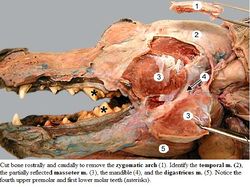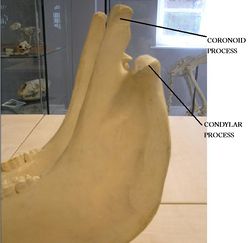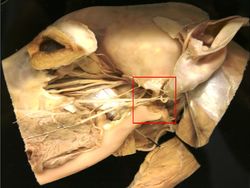Mastication
Overview
Mastication is the process whereby food is broken down by mechanical digestion in the oral cavity. The cheeks and tongue function to position food over the teeth, where grinding can occur. Mastication requires correct muscle movements and jaw articulation.
Rumination allows food to undergo mastication more than once. This is also called 'chewing the cud', it allows greater nutrients to be extracted and absorbed from the food particles.
Muscles of Mastication
The muscles of mastication are well developed.
Jaw Opening Muscles
The Digastricus muscle is the 'jaw opening' muscle. Its origin is the paracondylar process of the occipital bone. It inserts at the angle of the mandible. The muscle has two bellies; The caudal half from the second visceral arch innervated by the facial nerve (CN VII) and the cranial half from the first visceral arch, innervated by the mandibular branch of the trigeminal nerve (CN V3).
Jaw Closing Muscles
All jaw closing muscles are derived from the first visceral arch and are innervated by the mandibular branch of the trigeminal nerve (CN V3).
The masseter muscle originates from the maxilliary region of the skull and the zygomatic arch. It inserts on the wide area on the caudal side of the mandible. It has several divisions and causes unilateral and bilateral contraction. It also protrudes the jaw.
The lateral pterygoid muscle originates from the pterygopalatine region of the skull. It inserts on the lateral aspect of the mandible. It also protrudes the jaw (one-sided contraction).
The medial pterygoid muscle originates from the pterygopalatine region of the skull. It inserts on the medial aspect of the mandible. It causes one-sided contraction to close the jaw.
The temporal muscle originates from the lateral surface of the cranium. It inserts on the coronoid process. It pulls the mandible dorsally and also pulls the mandible rostrally (overbite) and caudally (underbite).
Lateral Translation of the Mandible
The masseter muscle and the contralateral medial and lateral pterygoids are involved in the lateral translation of the mandible.
Jaw Articulation
Temporomandibular Joint
The articulation between the condylar process of the mandible and the mandibular process of the skull. It is a compartmentalised joint for rotational movement and lateral slide (grinding). It is a synovial joint. Caudal dislocation is prevented by a prominent retro-articular process (enlargement of the fossa).
Mandibular Symphasis
Located at the rostral end of the mandible. It is a fibrous joint between the left and right halves of the mandible. It is only found in dogs and ruminants. It has a precise occlusion and the Mandibular bones can move apart independently by rotation. It stops jaw breakages (Canid).
Species Differences
Hebivores
Herbivores have large masseter and pterygoid muscles for extensive chewing. Herbiverous species have a limited digastricus muscle. In the horse, the muscle insertion site for the masseter is large to snap jaw shut.
Carnivores
Carnivores have a large temporalis muscle for snapping the jaw shut, e.g. in lions and pitbull terriers. Canids have a larger digasticus muscle than herbivores (but smaller in comparison with jaw closing muscles). In the dog, large forces are needed to shut the jaws, so the point of articulation of the temporomandibular joint is level with the teeth.
Links
Click here for Skull and Facial Muscles - Anatomy & Physiology
| Mastication Learning Resources | |
|---|---|
 Test your knowledge using drag and drop boxes |
Canine Head Skeletal Anatomy Resource (VI) |
 Test your knowledge using flashcard type questions |
Mastication Flashcards Facial Muscles flashcards |
 Selection of relevant videos |
Lateral surface of the head of a dog Lateral section through the head of a dog |
Error in widget FBRecommend: unable to write file /var/www/wikivet.net/extensions/Widgets/compiled_templates/wrt69390ba367d300_18308640 Error in widget google+: unable to write file /var/www/wikivet.net/extensions/Widgets/compiled_templates/wrt69390ba375bc11_23852434 Error in widget TwitterTweet: unable to write file /var/www/wikivet.net/extensions/Widgets/compiled_templates/wrt69390ba385eb13_02093075
|
| WikiVet® Introduction - Help WikiVet - Report a Problem |


